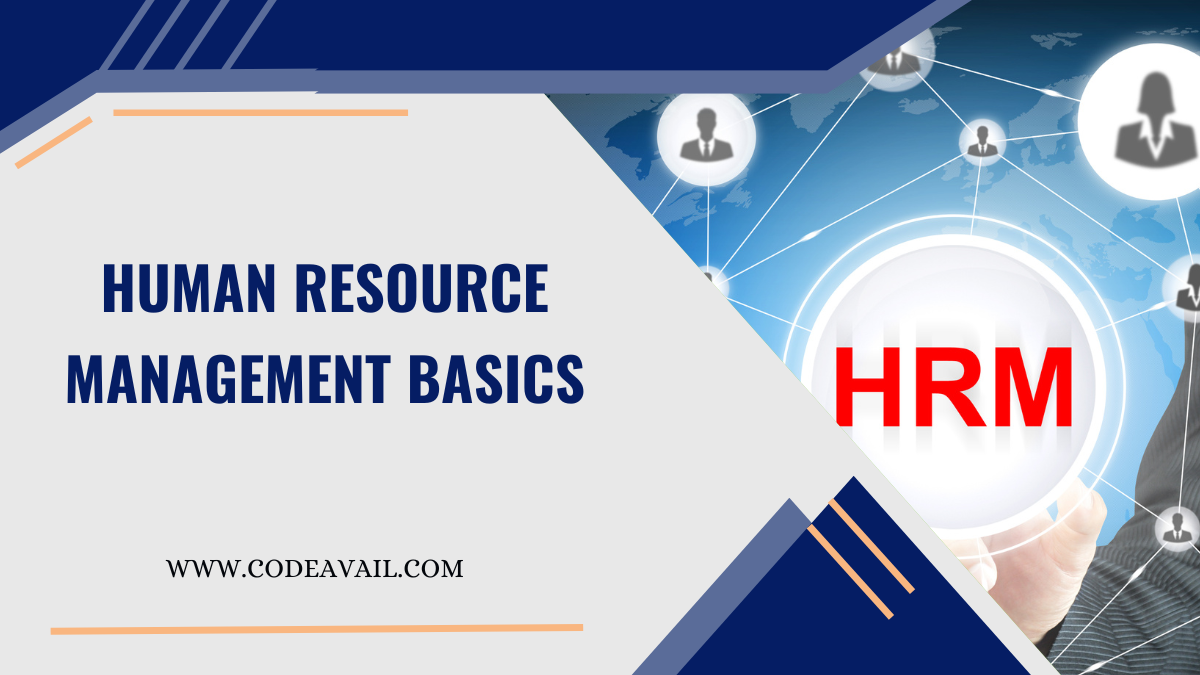People are very important to the growth of any business. The way workers do their jobs can either hurt or help a business. It will depend on you a lot as an HR worker how well your company does. All businesses, no matter how big or small, need to have good Human Resource Management (HRM). We will talk about the basics of Human Resource Management in this piece.
To begin, we will quickly talk about HRM and HR. Then we’ll talk about the seven most important HR terms you need to know to fully grasp what HR does. Finally, we will talk about some technical words, such as HRIS (Human Resources Information System).
What does Human Resource Management Mean?
Allow me to begin by giving a short explanation. HRM stands for “Human Resource Management.” It is the process of handling people to get better work done.
For instance, when you hire people for a job, you want them to fit in with the company culture. This is because they will be happier, stay longer, and be more effective than people who don’t fit in.
Engagement is another one. When workers are engaged, they work harder, do better work, and make customers happier. In other words, we help the company if we can find ways to get workers more involved.
The human resources department gives the company’s information, tools, training, legal advice, administration, and talent management, all of which are important for the business to stay alive and grow.
Better control of human resources is what human resource management is all about: making the company run better. The next question is: Who are these HR people?
Note: If you are a student and struggling with your Human Resource Management Assignment, then you can get the best Human Resource Management Assignment Help from our experts.
What is an HR department?
People might sound a little strange when you call them “human resources.” In one way or another, human resources are all the people who work for or help a company.
These are the people who work for a company. In this case, they could be regular workers or contractors. More and more people are working for a company on a contract basis without a standard work contract. This is especially true as the “gig economy” grows.
People in this group include freelancers, contract workers, on-call workers, and people who work for temporary help agencies.
An agency worker might only work at 20 different companies in one year, but an independent contractor might work for the same company for years. Each of these people has a different level of involvement with the company, so the way they are managed and active in the business should also be different.
The seven basics of HR
In Human Resource Management, there are a few things that are thought to be essential for making policies that work. These are the foundations:
- Recruitment and choice
- Management of performance
- Learning and growth
- Planning for succession
- Get paid and get perks
- Information Systems for Human Resources
- Data and insights for HR
We’ll go over these HR basics one by one in the next line.
1. Hiring and picking people
Recruiting and choosing employees may be the most obvious parts of HR. We all remember our first job interview, right?
One of HR’s main jobs is to find job candidates and hire the best ones. Getting the right people is very important for any business because they are its heart.
As soon as a new job opens up or an old job closes, people start looking for new employees. Second, the direct manager gives the job description to HR. Next, HR starts looking for people to fill the position. There are different tools that HR can use in this process to find the best person for the job. Some of these are conversations, different kinds of tests, checking references, and other ways to hire people.
When there are a lot of applicants, HR may use tools to narrow down the list. When it comes to good candidates, these tools help sort the wheat from the chaff. The winners then move on to the next round, where they are asked and given a more thorough evaluation.
2. Handling of performance
Performance management is important once workers are on board. Management of performance is the second basic HR skill. It means letting people do their best work, which is good for the company’s bottom line.
Most of the time, workers are given clear tasks that they need to complete. Performance management is a way for workers to get feedback on their work and improve it so they can do their best.
Some types of feedback are official one-on-one reviews, 360-degree feedback tools that include reviews from coworkers, clients, and other contacts, and more casual feedback.
success management is usually done once a year, and it includes planning, monitoring, reviewing, and rewarding employee success. The result of this process lets you divide workers into groups of high performers, low performers, and high potentials, low potentials, and so on.
HR and management both have a part to play in making performance management work well. Usually, the direct manager takes the lead, with HR providing help. Managing success well is very important. When employees are given the freedom to do their best work, the company’s speed, long-term viability, and profit margin all go up. People who regularly do not do a good job may not be a good fit for their job or the culture of the company. This staff might need to be fired.
In addition, this is one of HR’s main jobs.
3. Growth and learning
Life events, the place and time period in which a person grows up, and many other cultural factors shape who they are. Learning and development in HR make sure that workers can adapt to new laws, technologies, and changes in how things are done.
Employees can reskill and upskill with the help of learning and development. When it comes to moving the company toward its long-term goals, good rules can really help with Learning & Development (L&D). One HR trend for 2023 is to make learning a part of everyday work and help workers get better at both hard and soft skills that help the company reach its goals.
A lot of companies already have funds set aside for learning and development. This budget is then split up among the employees. Trainees, future leaders, and other high-potential workers often get more training chances than other workers. People may come to a company with a wide range of skills and information. L&D gives workers a way to fill in gaps in their skills and grow as leaders. The 9-Box grid is a well-known way to connect performance management with learning and development (L&D) tasks. The HR department and managers can suggest different growth plans for people based on their performance and potential ratings.
4. Planning for succession
If a key employee leaves the company, succession planning helps the business figure out what to do next. For example, if a key senior manager quits, having a person ready will make sure things keep going and can save the company a lot of money.
Performance reviews and learning and development attempts are often used to plan who will take over after someone leaves. This leads to the formation of a talent pipeline. There are qualified people in this pool who are ready to fill senior roles if someone leaves. Being a good manager of people means building and maintaining this chain.
5. Pay and perks
Pay and perks are another important part of HR. Fair pay is important for keeping workers and keeping them motivated. Making sure that pay is fair and equal is one of the most important parts of human resource management.
A big part of getting the best people to work for you is making the right pay offer. The budget and earnings margins of the company must be taken into account. Pay raises should be watched over by HR, and standards of achievement should be set. HR may also do a pay check once in a while.
There are two types of compensation: main compensation and secondary compensation. Primary compensation means getting paid directly for work. This is usually a monthly salary, but it can also be based on results.
All secondary perks are rewards that don’t involve money. This can include paid time off, flexible hours, day care, pensions, a business car and laptop, and a lot more.
People should be rewarded in ways that make them want to work harder.
6. Information system for human resources
They are not HR standards, but tools that will help you do your job better. The first is the HRIS, which stands for “Human Resource Information System.” All of the above foundations are supported by an HRIS. An Applicant Tracking System (ATS) is one way that HR workers keep track of applicants and hires during the hiring process.
Some people use a performance management system to keep track of their own goals and rate their own success.
Inside L&D, a Learning Management System (LMS) is used to share content with other people in the company. Other HR tools are used to manage budgets and training approvals.
Payroll systems are often used by people who work in compensation, and there are also digital tools that can help with succession planning.
Most of the time, all of these tasks can be done in one system: the HRIS. But sometimes, these functions are managed by separate HR platforms.
In the end, working in HR involves a lot of technology, which is why we need to talk about HRIS when we talk about the basics of HR.
7. Data and analytics for HR
Finally, the last of the HR basics is all about data and analytics. HR has come a long way in the last five years in becoming more data-driven.
The Human Resource Information Systems we just talked about are mainly systems for entering data. We can use the information in these tools to help us make smarter choices.
HR measures, also called HR KPIs, make it easy to keep track of important data. These are specific measures that show how well a business is doing in a certain area. This process is called HR reporting.
This study is mostly about the organization’s past and present state. HR can also make predictions with the help of HR data. Some examples are the number of workers needed, the likelihood that an employee will leave, how the experience of a job candidate affects customer happiness, and many more.
HR can make better choices based on data if they actively measure and look at this data. It’s easier to get management to back these kinds of decisions because they are usually more logical.
In conclusion
You now know the seven most important things about HR management. All of these HR basics work together. All of them influence and are affected by each other. You can think of these seven basics as building blocks. If you manage each one well, it makes the next one stronger. All of these HR basics help employees not only do their jobs better, but also do their very best.









